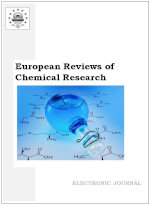1 September 27, 2021
Articles
1. Mohammad Asif
Biological Potential of Pyrazole, and Triazole Derivatives: A Mini Review
European Reviews of Chemical Research. 2021. 8(1): 3-16.
Number of views: 244 Download in PDF
2. Iliyasu A. A. Ibrahim, Hafizah Sani Sulaiman, Sulaiman Maikudi, Habibu MusaEuropean Reviews of Chemical Research. 2021. 8(1): 3-16.
Abstract:
The main objectives of this review to study of synthetic routes and biological activities of substituted Pyrazole, and 1,2,4-Triazole derivatives. These Pyrazole, and 1,2,4-Triazole derivatives have various types of biological activities such as antibacterial, antifungal. analgesic, antimicrobial, antiiflammatory, anticancer, antidepressant, anticonvulsant, anti-hyperglycemic, antipyretic, fungicidal, anti-arthritic and other biological activities. Moreover, some of the currently available drugs have been shown to exhibit unfavourable side effects and toxicity. It is well established that small modifications in the structure of the targets are altering their biological character as well as their physiochemical properties.
The main objectives of this review to study of synthetic routes and biological activities of substituted Pyrazole, and 1,2,4-Triazole derivatives. These Pyrazole, and 1,2,4-Triazole derivatives have various types of biological activities such as antibacterial, antifungal. analgesic, antimicrobial, antiiflammatory, anticancer, antidepressant, anticonvulsant, anti-hyperglycemic, antipyretic, fungicidal, anti-arthritic and other biological activities. Moreover, some of the currently available drugs have been shown to exhibit unfavourable side effects and toxicity. It is well established that small modifications in the structure of the targets are altering their biological character as well as their physiochemical properties.
Number of views: 244 Download in PDF
Isolation and Identification of Bacteria from Used Face Masks in Bauchi State University, Gadau
European Reviews of Chemical Research. 2021. 8(1): 17-21.
Number of views: 184 Download in PDF
3. European Reviews of Chemical Research. 2021. 8(1): 17-21.
Abstract:
The most traditional and realistic technique to avert the blowout of respiratory contaminations is to wear face masks; quite a few research clusters have established its efficacy against the spread of respiratory viruses before the COVID-19 pandemic. The current study aimed to isolate and identify bacteria from disposable face masks after use in Bauchi state university, Gadau. A total of 100 used face masks were collected from students of the university and subjected to microbiological and biochemical tests in order to isolate and identify the organisms from both the inner and outer surfaces of the used face masks. Most isolated bacterial contamination on both the outside area of the used face masks were Staphylococcus aureus 41.6 %, Escherichia coli 45.8 %, Streptococcus pneumoniae 8.3 % and Streptococcus mutans with 4.1 % but the number of organisms found on the outside were much lower. This study shows that the most abundant bacteria found in used face masks was Escherichia coli with the highest percentage of occurrence. The findings from this study show that bacteria were isolated from both the inner and outer surfaces of all the face masks used for this study, majority of which were Gram positive cocci. Only one-gram negative rod was identified and isolated.
The most traditional and realistic technique to avert the blowout of respiratory contaminations is to wear face masks; quite a few research clusters have established its efficacy against the spread of respiratory viruses before the COVID-19 pandemic. The current study aimed to isolate and identify bacteria from disposable face masks after use in Bauchi state university, Gadau. A total of 100 used face masks were collected from students of the university and subjected to microbiological and biochemical tests in order to isolate and identify the organisms from both the inner and outer surfaces of the used face masks. Most isolated bacterial contamination on both the outside area of the used face masks were Staphylococcus aureus 41.6 %, Escherichia coli 45.8 %, Streptococcus pneumoniae 8.3 % and Streptococcus mutans with 4.1 % but the number of organisms found on the outside were much lower. This study shows that the most abundant bacteria found in used face masks was Escherichia coli with the highest percentage of occurrence. The findings from this study show that bacteria were isolated from both the inner and outer surfaces of all the face masks used for this study, majority of which were Gram positive cocci. Only one-gram negative rod was identified and isolated.
Number of views: 184 Download in PDF








